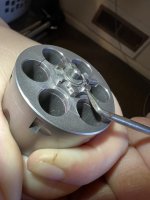Hello,
I am the owner of a 686 SSR pro and I am getting the feeling I just botched a trigger job. I have no prior gun smithing experience on revolvers but that does not mean I am mechanically illiterate. Prior to embarking on this adventure I bought Jerry Miculek's Trigger Job video. I followed step by step and after reassembly I thought I had successfully completed a trigger job. Aaaaaaaaand this is where the plot thickens.
Since I am pretty certain what the problem is, I am just going to focus on what I have found that definitely is not right just so I can make a long story short.
When i assemble my pistol, the first couple trigger pulls in double action feel normal. The hammer rises and falls, nice and smooth as it should. Eventually, right around 10 or 15 dry fires when pulling in double action the trigger stacks right at the end of the pull before the hammer drops. I found what is binding. My hand assembly is digging into the notches on my cylinder and becoming jammed. I think I have an idea as to why this is happening. I think I removed too much material from the sides of my rebound slide. Now the rebound slide has more room to walk sideways which is applying a force to my trigger lever which transmits to my trigger where the arm assembly is attached which throws the alignment of the arm assembly off.
I am pretty confident this is the problem, now I am worried that I just smoked a cylinder . I am about to order a new rebound slide. If that fixes the problem great, but now I have a cylinder that is marred from my misaligned arm assembly. My dumb *** should have known when to stop. I am hesitant to try and smooth out the marred surface on the cylinder because I am worried about throwing off the timing.
. I am about to order a new rebound slide. If that fixes the problem great, but now I have a cylinder that is marred from my misaligned arm assembly. My dumb *** should have known when to stop. I am hesitant to try and smooth out the marred surface on the cylinder because I am worried about throwing off the timing.
My thinking is that by the time the binding occurs, the cylinder is already locked into position. In a properly assembled pistol, the hand assembly moves straight up. In my pistol the arm assembly is not moving straight up, therefore the material I would remove from the cylinder might not affect the timing. I have a feeling it might not be that simple. I will try and post picks of what the cylinder looks like. I know pictures speak a thousand words.
I am probably going to send my gun to smith and wesson and have them repair what I did but I figured I would check here first and see if I can fix what I messed up. I think I already know the answer though because in the Jerry's video, the surface on the cylinder he said not to stone is the surface I messed up with my hand assembly.
I am the owner of a 686 SSR pro and I am getting the feeling I just botched a trigger job. I have no prior gun smithing experience on revolvers but that does not mean I am mechanically illiterate. Prior to embarking on this adventure I bought Jerry Miculek's Trigger Job video. I followed step by step and after reassembly I thought I had successfully completed a trigger job. Aaaaaaaaand this is where the plot thickens.
Since I am pretty certain what the problem is, I am just going to focus on what I have found that definitely is not right just so I can make a long story short.
When i assemble my pistol, the first couple trigger pulls in double action feel normal. The hammer rises and falls, nice and smooth as it should. Eventually, right around 10 or 15 dry fires when pulling in double action the trigger stacks right at the end of the pull before the hammer drops. I found what is binding. My hand assembly is digging into the notches on my cylinder and becoming jammed. I think I have an idea as to why this is happening. I think I removed too much material from the sides of my rebound slide. Now the rebound slide has more room to walk sideways which is applying a force to my trigger lever which transmits to my trigger where the arm assembly is attached which throws the alignment of the arm assembly off.
I am pretty confident this is the problem, now I am worried that I just smoked a cylinder
My thinking is that by the time the binding occurs, the cylinder is already locked into position. In a properly assembled pistol, the hand assembly moves straight up. In my pistol the arm assembly is not moving straight up, therefore the material I would remove from the cylinder might not affect the timing. I have a feeling it might not be that simple. I will try and post picks of what the cylinder looks like. I know pictures speak a thousand words.
I am probably going to send my gun to smith and wesson and have them repair what I did but I figured I would check here first and see if I can fix what I messed up. I think I already know the answer though because in the Jerry's video, the surface on the cylinder he said not to stone is the surface I messed up with my hand assembly.
Attachments
Last edited by a moderator:



